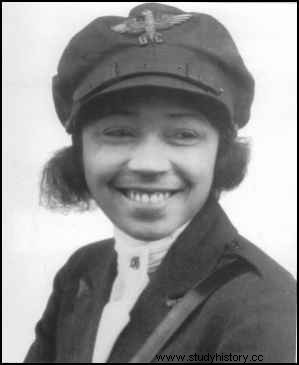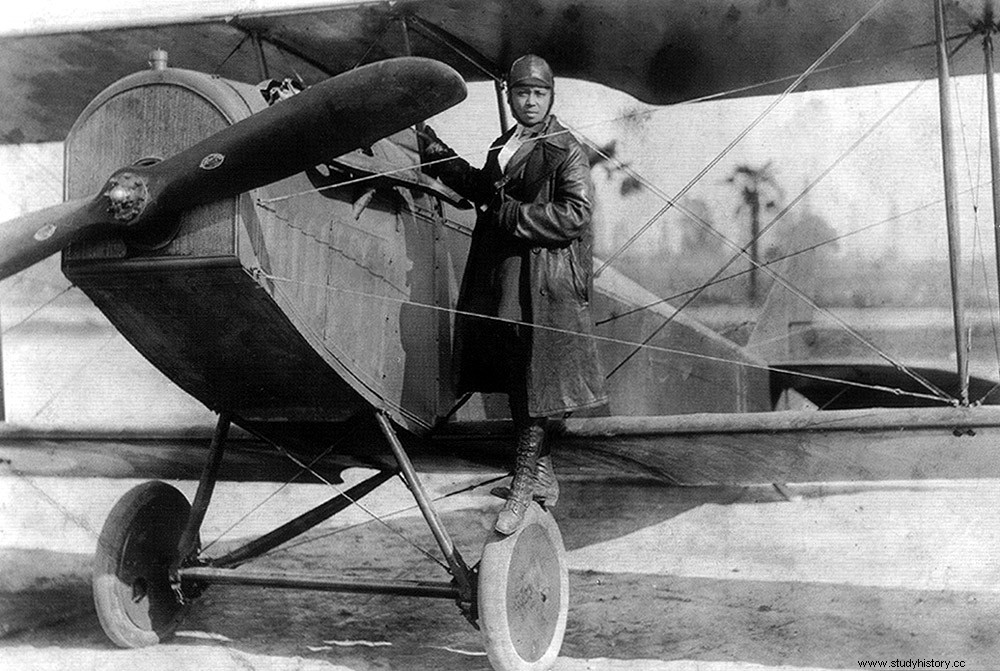Bessie Coleman (1892 – 1926) was an American aviator. In 1921, she became the first black woman to earn a pilot's license.

A gifted student
 Daughter of Susan and George Coleman, Bessie was born in Atlanta (Texas) on January 26, 1892. She is the tenth of thirteen children. When Bessie was two years old, her family moved to Waxahachie (Texas), where she was educated. She must then walk more than six kilometers a day to reach her school reserved for black students, where she develops her taste for reading and proves to be very gifted in mathematics.
Daughter of Susan and George Coleman, Bessie was born in Atlanta (Texas) on January 26, 1892. She is the tenth of thirteen children. When Bessie was two years old, her family moved to Waxahachie (Texas), where she was educated. She must then walk more than six kilometers a day to reach her school reserved for black students, where she develops her taste for reading and proves to be very gifted in mathematics.
In 1901, George, no longer supporting the ubiquitous racial segregation in Texas, left his family to settle in Oklahoma. Bessie was then nine years old. She continued her studies and, at eighteen, took her savings to enroll in Oklahoma Colored Agricultural and Normal University (now Langston University). When the money runs out, she goes home.
The Caudron brothers’ school
In 1915, Bessie Coleman left to join her brothers in Chicago where she was hired as a manicurist. In her hairdressing salon, she hears the stories of pilots returning from the First World War and develops a keen interest in aviation. Because she is a woman and she is black, she is not admitted to American flight schools and no black American aviator agrees to instruct her. Bessie then receives financial support from a banker named Jesse Binga and the Chicago Defender (newspaper defending the black cause) to go and train in France. After a few French lessons, she left for Paris on November 20, 1920. It was at the Caudron flying school in Crotoy that she learned to fly a Nieuport Type 82 biplane.
A media phenomenon
 On June 15, 1921, Bessie Coleman obtained her International Pilot's License from the International Aeronautical Federation, becoming the first woman pilot of African-American origin. Despite everything, no one wants to continue to train her in the United States and she still takes some lessons in France, the Netherlands and Germany. Deeming herself finally sufficiently trained, she returned to New York to embark on a career in aerial demonstration. During the next five years, she will become a real media phenomenon. Invited to important events, frequently requested by the media, admired by blacks and whites alike, she is recognized for her piloting skills and her audacity. On February 22, 1923, she broke her leg and three ribs when her plane crashed.
On June 15, 1921, Bessie Coleman obtained her International Pilot's License from the International Aeronautical Federation, becoming the first woman pilot of African-American origin. Despite everything, no one wants to continue to train her in the United States and she still takes some lessons in France, the Netherlands and Germany. Deeming herself finally sufficiently trained, she returned to New York to embark on a career in aerial demonstration. During the next five years, she will become a real media phenomenon. Invited to important events, frequently requested by the media, admired by blacks and whites alike, she is recognized for her piloting skills and her audacity. On February 22, 1923, she broke her leg and three ribs when her plane crashed.
A flight school for young African Americans
Bessie Coleman plans to open a flight school for young African Americans, but she will not live long enough to realize this dream. On April 30, 1926, in Jacksonville, she flew aboard a Curtiss JN-4 to Dallas despite the advice of those around her who did not trust the aircraft. Its mechanic, William Wills, flies the plane while the young pilot, who is not wearing her seatbelt, surveys the terrain in preparation for a parachute jump the next day. After ten minutes of flight, the plane went into a spin and Bessie was ejected 600 meters from the ground; she dies instantly. The pilot, who was unable to regain control of the aircraft, also died during the crash.
On May 2, 1926, thousands of people attended Bessie Coleman's funeral.
